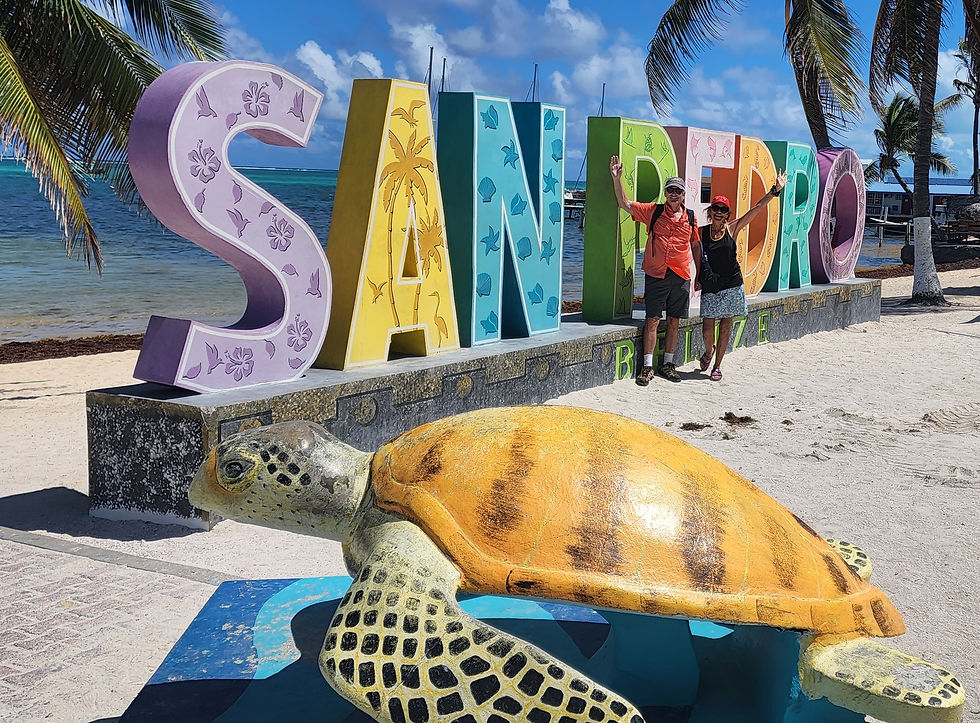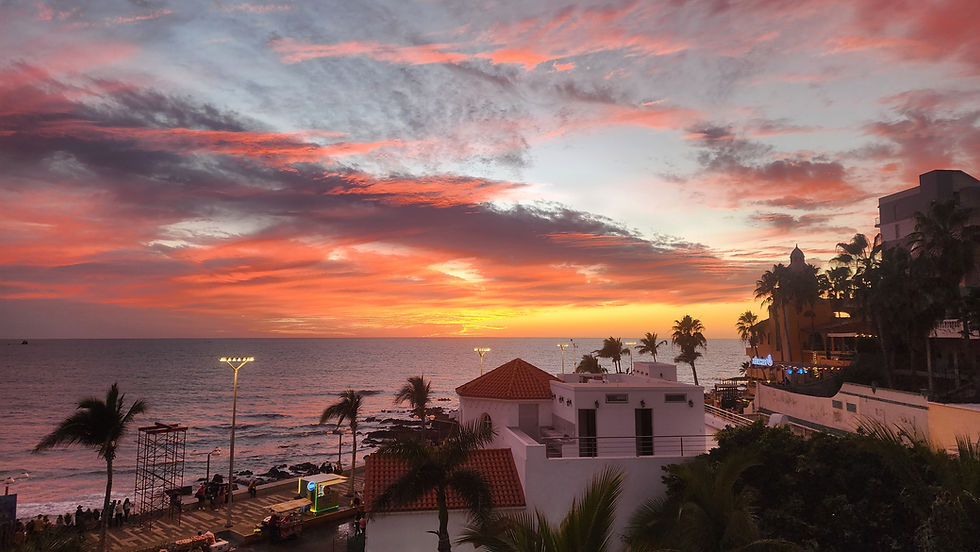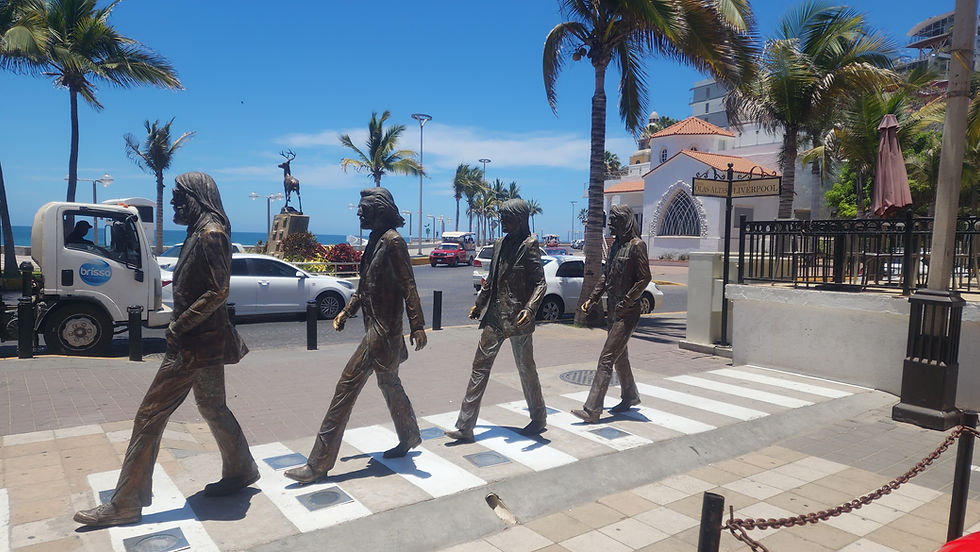You Better Belize It!
- Bil
- Jun 1, 2022
- 8 min read

This cheerful slogan pops up many places: posters, t-shirts & random signs, and really typifies most locals we met – friendly, helpful, and just downright nice.
Heeding our previous lesson in bus seating, we stood on the corner near our hotel in San Ignacio to flag down the bus before it got into town and grabbed an empty seat. 10 minutes later it was standing room only as all the folks waiting in the town square piled on board.
We chugged eastward on the Western Highway towards Belmopan, passing gaily colored bus stops decorated with the village names like Esperanza, Georgeville, Ontario Village and Teakettle. Several small roads led north to the settlement of Spanish Lookout, the largest community of Mennonites in Belize.

Groups of Mennonites have migrated several times through the last four centuries, to practice their Christian faith and customs of pacifism without interference. Originating in central Europe, a contingent of about 7,000 souls moved to Canada in the late 19th century. When the influence of WWI was felt the Canadian government began “patriotic” reforms of the public school system, including the Mennonites’ territories. The more conservative among them took umbrage at these reforms and decided to move south, ending up in the Chihuahua district of Mexico.

Farming in Mexico was much different than central Canada. Much higher temperatures, different soil composition and irrigation was a necessity. By the mid-20th century, “reforms” to the Mexican schools and possibilities of compulsory military service prompted some members of the community to actively look for new opportunities and discovered British Honduras in 1957.
They found a country chafing under the rule of the United Kingdom, which had recently taken over the logwood and “Chicle” (chewing gum) business from local companies. This kick-started a peaceful revolution for independence, but the nascent Peoples United Party realized a new country would not have the infrastructure to feed itself.
This serendipitous meeting between the industrious Mennonites and the leaders of an emerging country resulted in a mutually beneficial agreement: the Mennonites would receive a large tract of land in the western part of the country, with freedom to practice their religion and no obligation to military service, and in return would produce enough large-scale agriculture to feed most of British Honduras, as well as themselves.
This proved to be a good arrangement. Today, the Mennonites produce over 85% of the poultry and dairy products in Belize, as well as a large portion of cattle, vegetables, hardware and building supplies. They have helped Belize develop a solid, sustainable agricultural industry that was key to its independence. The Mennonite communities also have excellent reputations as carpenters and home builders. (click here for more info on Mennonites in Belize)

After a short stop in Belmopan the bus continued towards Belize City, with an increase of traffic and roadside buildings. We arrived at the bus terminal and exited to the usual mass confusion of a small but busy station, with a noisy mix of taxi drivers, porters, tour operators and scammers – all clamoring for your business. In short order we were collared by a self-assured gentleman in a pseudo-nautical outfit, who rightly guessed we need to get to the water taxi, and onwards to Ambergris Caye. Get out your wallet – sign here – off you go!
“Belize Town” was founded by the British in 1638 on the banks of Haulover Creek – site of the former Maya village of Holzuz - as a convenient port for the logwood business. Spanish conquistadors explored Belize first but decided not to colonize it, but the British discovered logwood made an excellent dye for fabrics and made a good trade of it. When aniline dyes replaced logwood, mahogany became the choice of the lumber industry.

Following a short taxi ride to the ferry docks, we checked in at the office, then grabbed a couple of tasty samosas from an Indian café near the wharf. Boarding the Belize Express Water Taxi we climbed to the upper deck, joining about 8 others and the captain, while the main cabin held about 100. It was a pleasant 90 minutes, cruising across the turquoise shallow, western edge of the Caribbean Sea inside the reef line, with a short stop at the small island of Caye Caulker before docking at San Pedro on Ambergris Caye.
Mark, our pet-sitting host was waiting for us at the docks and helped collect our bags and carry to his golf cart, emblazoned with a large Ohio State sticker on the front. Golf carts are the predominant mode of transport on Ambergris Caye for several reasons: high cost of gas (about 7USD/gallon today), bumpy narrow roads, and high cost of auto repairs. There are a few autos, but mostly Toyota vans used as taxis and trucks for construction. Also a few small motorbikes and bicycles.

Mark drove us south towards his condo, pointing out various landmarks, stores, and restaurants, as well as the frequent, and jarring speed bumps. When we arrived at the condo we were greeted by the beautiful Patches, who could be a sister to Jazz’s sweet Lucy – with a few white patches in her fur. She is a sweet and energetic rescue, about 2 years old – who loves to chase coconut seeds along the beach. Nancy joined us shortly after, and they took us out to La Divinas for some delicious pupusas, round cakes of corn flour with a variety of fillings, cooked on a griddle and served with salsa roja. Yum!
Next day Mark & Nancy were off to the tiny airport in San Pedro to start a vacation in the US, and we settled into life on Ambergris Caye (AC). Although everyone calls AC an island (many signs & stickers for La Isla Bonita – pre or post Madonna? - idk), it is really a peninsula about 1 mile wide, extending down from Mexico, although the roads do not go that far. About 24 miles north to the Mexican border, and another 10 miles past that to the mainland. So it can only be reached by air or by sea.

If Placencia reminded me of Bimini back in the ‘70s, AC is more like Key West of the same time. It is the wealthiest and most tourist-oriented area of Belize. Originally settled by Mayas escaping Spanish persecution who survived by fishing, it is now home to a thriving tourist industry. One main road splits into three (nicknamed Front Street, Middle Street & Back Street!) through San Pedro, with the cobblestones giving way to coral, gravel and sand outside of town. A colorful jumble of shops, food stalls, restaurants, hotels, cart rentals and grocery stores line the main street, with local homes & shops on the side streets.
We were staying in a 3/2 ground floor condo that looked eastward right out on the pool, beach and the Caribbean Sea. Several units are occupied by full-time residents who have become good friends in a short time. Most days a strong onshore wind was blowing and the rumble of the surf breaking on the reef half a mile offshore was always in the air. The shallow water between the reef and shore varied from glassy on calm days, to choppy white caps, still easily traversed by small boats.

There is a large population of expats on AC – mostly from the US and Canada. The tropical location on the water along with cheaper property are the big draws, while the price of goods is usually more expensive. Many native Belizeans also live on AC but many also commute over from the mainland – some daily and some stay for the work-week – taking the water taxi back on Friday evening. Roger was the amiable young caretaker for the condo and best buddy of Patches, who spent eves and weekends playing on a top-rated national soccer team.
One of the first things Susie did was sign us up for Pickleball lessons! Gerri had recently taken over the Mata Rocks Resort and put in two courts especially for pickleball, also starting a six-session class for beginners. We arrived for the 3rd class, and had a great time learning from Jason, who was patient and fun, teaching us the basics along with 5 other beginners. Pickleball is kinda like tennis-light – played on a slightly smaller court, with hard paddles and a light ball, similar to a whiffle ball. Play is slower than tennis, mostly doubles, and usually involves all 4 players volleying back and forth, close to the net.

We started at 8am each morning, and it was already hot! Everyone was already angling to get the (partially) shaded court, but Jason had us switching up regularly, and stopping for frequent water breaks. By quitting time at 10am I was completely soaked and rinsed off at the pool shower, changing into dry clothes before moving on to iced coffee & almond croissants at the French Bakery across from the airport.
Susie and I took turns driving the cart, very slowly to minimize the bumping and banging, causing every other driver to pass us wherever we went. The speed humps were marked well, but narrow drainage gullies at every crossroad and some random locations would sometimes get overlooked, shaking our fillings! We are going to petition the local government to paint all these hazards a bright yellow.
Skylar was able to join us for a couple of weeks after finishing her degree at FIU. Congrats Sky-Girl! She will next be working on her masters at Barry University in Miami. We were eager to show her around, so we took a trip up to Secret Beach north of San Pedro.

Secret Beach was just that about 10 years ago – a secluded stretch along the western, and leeward side of AC – with gorgeous views of the sunset over the mainland in the distance. Today it is changing fast with many waterfront bars and restaurants to choose from. The previously lonely stretch of road from San Pedro to Secret Beach is slowly being populated with staked-out lots and small homes.
Our trip by golf cart took about an hour, heading north along the eastern coastal road over bumpy paved roads that gave way to even rougher gravel and rock, and turning west for the last 2 miles. As we approached the water where the road hits a tee, we were greeted by a number of signs for different establishments, along with enthusiastic hawkers urging folks along to “the best place around”.

Word on the street is that if you are looking for the party bars, loud music, and strong drinks – turn right at the tee. We turned left! A short way down that road and more choices so we kept to the left and pulled into the Sunset Palace Beach Club, where we were met by Donovan with rum shots. They had a nice assortment of covered lounge chairs and picnic tables, most on land but also some in the warm water under palapas, a bar & kitchen, pool and pier.
We enjoyed a lovely afternoon drinking piña coladas & munching on snacks while sitting in the clear azure water or reclining in the loungers. Susie & Sky took a paddle board out to explore the shallow waters of the lagoon while I caught up on some reading. It was a beautiful and peaceful afternoon away from the constant trade winds and sargassum on the ocean side.
Caye Caulker is a small, skinny island (4 miles long) about 10 miles south of Ambergris Caye, sporting the motto of “Go Slow”. Something to check out – right? We bought tickets online for the 10:45 water taxi and almost missed it after standing in line to board for 20 minutes and finding out just before loading that the online boarding passes are not accepted – you have to stand in a different line to get a paper ticket as well. Sheesh.

The crossing was quick and easy inside the reef, and we were moseying down the dirt road looking for coffee, finding just the right place at Ice & Beans! Iced coffee & bagels to start – life is good. Continuing our walk north we came to The Split, a channel that divides the smaller, busier southern part from the northern portion. The Lazy Lizard bar & grill covers the southern shoreline of The Split with water sports, food & drink.
We walked along the backside of the island admiring the local fishing & dive boats, cottages and guest houses. Looping back around to the “main street” we stopped a couple more times to fortify ourselves with various combinations of food & drink, with a delicious snack at Caribbean Colors Art Café & drinks at No Bad Days Sports Bar.

Caye Caulker has a reputation as a party spot among some, and we did see more younger folks there than AC, but overall it seemed much quieter and laid back; a good place to just grab a drink, sit back and listen to the surf as you soak up the sun.
Ok, time to wrap this up. A few more adventures in Belize to write about, so stay tuned for part 3!








Comments